Fiber Bragg Grating Pressure Sensor Integrated with Epoxy Diaphragm
Abstract
1. Introduction
2. Materials and Methods
2.1. FBG Sensing Principle
2.2. Design and Fabrication of FBG Pressure Sensor
2.3. Experimental Setup and Measurements
3. Results and Discussion
4. Conclusions
Author Contributions
Funding
Institutional Review Board Statement
Informed Consent Statement
Data Availability Statement
Conflicts of Interest
References
- Bukhari, S.F.A.; Yang, W. Multi-interface level sensors and new development in monitoring and control of oil separators. Sensors 2006, 6, 380–389. [Google Scholar] [CrossRef]
- Sarath, T.M.; Subha Hency, J.P.; Daniel, F. Level measurement using MEMS pressure sensor. Int. J. Adv. Res. Comp. Sci. Softw. Eng. 2013, 3, 118–121. [Google Scholar]
- Luo, J.; Hao, Y.; Ye, Q.; Hao, Y.; Li, L. Development of optical fiber sensors based on brillouin scattering and FBG for on-line monitoring in overhead transmission lines. J. Lightwave Technol. 2013, 31, 1559–1565. [Google Scholar] [CrossRef]
- Chen, C.; Yu, Y.-S.; Yang, R.; Wang, C.; Guo, J.-C.; Xue, Y.; Chen, Q.-D.; Sun, H.-B. Reflective optical fiber sensors based on tilted fiber Bragg gratings fabricated with femtosecond laser. J. Lightwave Technol. 2013, 31, 455–460. [Google Scholar] [CrossRef]
- Mihailov, S.J. Fiber bragg grating sensors for harsh environments. Sensors 2012, 12, 1898–1918. [Google Scholar] [CrossRef]
- Huang, J.; Zhou, Z.; Wen, X.; Zhang, D. A diaphragm-type fiber Bragg grating pressure sensor with temperature compensation. Measurement 2013, 46, 1041–1046. [Google Scholar] [CrossRef]
- Liang, M.-F.; Fang, X.-Q.; Wu, G.; Xue, G.-Z.; Li, H.-W. A fiber bragg grating pressure sensor with temperature compensation based on diaphragm-cantilever structure. Optik 2017, 145, 503–512. [Google Scholar] [CrossRef]
- Majumder, M.; Gangopadhyay, T.K.; Chakraborty, A.K.; Dasgupta, K.; Bhattacharya, D.K. Fiber Bragg gratings in structural health monitoring-present status and applications. Sens. Act. A 2008, 147, 150–164. [Google Scholar] [CrossRef]
- Guo, H.L.; Xiao, G.Z.; Mrad, N.; Yao, J.P. Fiber optic sensors for structural health monitoring of air platforms. Sensors 2011, 11, 3687–3705. [Google Scholar] [CrossRef] [PubMed]
- Allwood, G.; Wild, G.; Lubansky, A.; Hinckley, S. A highly sensitive fiber Bragg grating diaphragm pressure transducer. Opt. Fiber Technol. 2015, 25, 25–32. [Google Scholar] [CrossRef]
- Wang, X.X.; Wu, C.Y. Pressure sensitivity researched on the metal coated FBG sensors. Adv. Mater. Res. 2012, 462, 160–163. [Google Scholar] [CrossRef]
- Lai, C.-W.; Lo, Y.-L.; Yur, J.-P.; Liu, W.-F.; Chuang, C.-H. Application of Fabry–Pérot and fiber Bragg grating pressure sensors to simultaneous measurement of liquid level and specific gravity. Measurement 2012, 45, 469–473. [Google Scholar] [CrossRef]
- Zhao, Y.; Zheng, H.-K.; Lv, R.-Q.; Yang, Y. A practical FBG pressure sensor based on diaphragm-cantilever. Sens. Actuators A: Phys. 2018, 279, 101–106. [Google Scholar] [CrossRef]
- Hong, C.; Yuan, Y.; Yang, Y.; Zhang, Y.; Abro, Z.A. A simple FBG pressure sensor fabricated using fused deposition modelling process. Sens. Actuators A: Phys. 2019, 285, 269–274. [Google Scholar] [CrossRef]
- Leal-Junior, A.G.; Díaz, C.A.R.; Frizera, A.; Marques, C.; Ribeiro, M.R.N.; Pontes, M.J. Simultaneous measurement of pressure and temperature with a single FBG embedded in a polymer diaphragm. Opt. Laser Technol. 2019, 112, 77–84. [Google Scholar] [CrossRef]
- Zhao, Q.; Zheng, H.-K.; Lv, R.-Q.; Gu, Y.-F.; Zhao, Y.; Yang, Y. Novel integrated optical fiber sensor for temperature, pressure and flow measurement. Sens. Actuators A: Phys. 2018, 280, 68–75. [Google Scholar] [CrossRef]
- Stephens, A.F.; Busch, A.; Salamonsen, R.F.; Gregory, S.D.; Tansley, G.D. A novel fibre Bragg grating pressure sensor for rotary ventricular assist devices. Sens. Actuators A: Phys. 2019, 295, 474–482. [Google Scholar] [CrossRef]
- Ameen, O.F.; Younus, M.H.; Aziz, M.S.; Azmi, A.I.; Raja Ibrahim, R.K.; Ghoshal, S.K. Graphene diaphragm integrated FBG sensors for simultaneous measurement of water level and temperature. Sens. Actuators A 2016, 252, 225–232. [Google Scholar] [CrossRef]
- Al-Fakih, E.A.; Abu Osman, N.A.; Mahamd Adikan, F.R.; Eshraghi, A.; Jahanshahi, P. Development and validation of fiber Bragg grating sensing pad for interface pressure measurements within prosthetic sockets. IEEE Sens. J. 2016, 16, 965–974. [Google Scholar] [CrossRef]
- Gutierrez-Rivera, M.; Jauregui-Vazquez, D.; Sierra-Hernandez, J.M.; Garcia-Mina, D.F.; Lopez-Dieguez, Y.; Estudillo-Ayala, J.M.; Rojas-Laguna, R. Low-pressure fiber-optic sensor by polyester Fabry-Perot cavity and its phase signal processing analysis. Sens. Actuators A: Phys. 2020, 315, 112338. [Google Scholar] [CrossRef]
- Leal-Junior, A.; Frizera, A.; Marques, C. A fiber Bragg gratings pair embedded in a polyurethane diaphragm: Towards a temperature-insensitive pressure sensor. Opt. Laser Technol. 2020, 131, 106440. [Google Scholar] [CrossRef]
- Wang, W.; Zhou, X.; Wu, W.; Chen, J.; He, S.; Guo, W.; Gao, J.; Huang, S.; Chen, X. Monolithic Structure-Optical Fiber Sensor with Temperature Compensation for Pressure Measurement. Materials 2019, 12, 552. [Google Scholar] [CrossRef]
- Liu, X.; Wang, Y.; Zhang, M. Application of Miniature FBG-MEMS Pressure Sensor in Penetration Process of Jacked Pile. Micromachines 2020, 11, 876. [Google Scholar] [CrossRef] [PubMed]
- Cheng, X.; Dash, J.N.; Gunawardena, D.S.; Htein, L.; Tam, H.-Y. Silicone Rubber Based Highly Sensitive Fiber-Optic Fabry–Perot Interferometric Gas Pressure Sensor. Sensors 2020, 20, 4927. [Google Scholar] [CrossRef] [PubMed]
- Xu, M.G.; Reekie, L.; Chow, Y.T.; Dakin, J.P. Optical in-fiber grating high pressure sensor. Electron. Lett. 1993, 29, 398–399. [Google Scholar] [CrossRef]
- Ahmad, H.; Harun, S.W.; Chong, W.Y. High-sensitivity pressure sensor using a polymer embedded FBG. Microw. Opt. Technol. Lett. 2008, 50, 60–61. [Google Scholar] [CrossRef]
- Vorathin, E.; Hafizi, Z.M.; Ismail, N.; Loman, M. Review of high sensitivity fibre-optic pressure sensors for low pressure sensing. Opt. Laser Technol. 2020, 121, 105841. [Google Scholar] [CrossRef]
- Peng, B.J.; Zhao, Y.; Yang, J.; Zhao, M.G. Pressure sensor based on a free elastic cylinder and birefringence effect on an FBG with temperature-compensation. Measurement 2005, 38, 176–180. [Google Scholar] [CrossRef]
- Sengupta, D.; Shankar, M.S.; Reddy, P.S.; Prasad, R.L.N.S.; Srimannarayana, K. Sensing of hydrostatic pressure using FBG sensor for liquid level measurement. Microw. Opt. Technol. Lett. 2012, 7, 1679–1683. [Google Scholar] [CrossRef]
- Yang, Y.; Hong, C.; Abro, Z.A.; Wang, L.; Yifan, Z. A new Fiber Bragg Grating sensor based circumferential strain sensor fabricated using 3D printing method. Sens. Actuators A 2019, 295, 663–670. [Google Scholar] [CrossRef]
- Her, S.C.; Hsu, W.C. Sensing Performance and Mechanical Properties of Buckypaper Impregnated with Epoxy Resin. Nanomaterials 2020, 10, 2258. [Google Scholar] [CrossRef] [PubMed]
- Song, D.; Zou, J.; Wei, Z.; Chen, Z.; Cui, H. Liquid-level sensor using a fiber Bragg grating and carbon fiber composite diaphragm. Opt. Eng. 2011, 50, 014401. [Google Scholar] [CrossRef]
- Pachava, V.R.; Kamineni, S.; Madhuvarasu, S.S.; Putha, K. A high sensitive FBG pressure sensor using thin metal diaphragm. J. Opt. 2014, 43, 117–121. [Google Scholar] [CrossRef]
- Marques, C.A.F.; Peng, G.-D.; Webb, D.J. Highly sensitive liquid level monitoring system utilizing polymer fiber Bragg gratings. Opt. Express 2015, 23, 6058–6072. [Google Scholar] [CrossRef]
- Díaz, C.A.R.; Leal-Junior, A.G.; André, P.S.B.; da Costa Antunes, P.F.; Pontes, M.J.; Frizera-Neto, A.; Ribeiro, M.R.N. Liquid Level Measurement Based on FBG-Embedded Diaphragms with Temperature Compensation. IEEE Sens. J. 2018, 18, 193–200. [Google Scholar] [CrossRef]
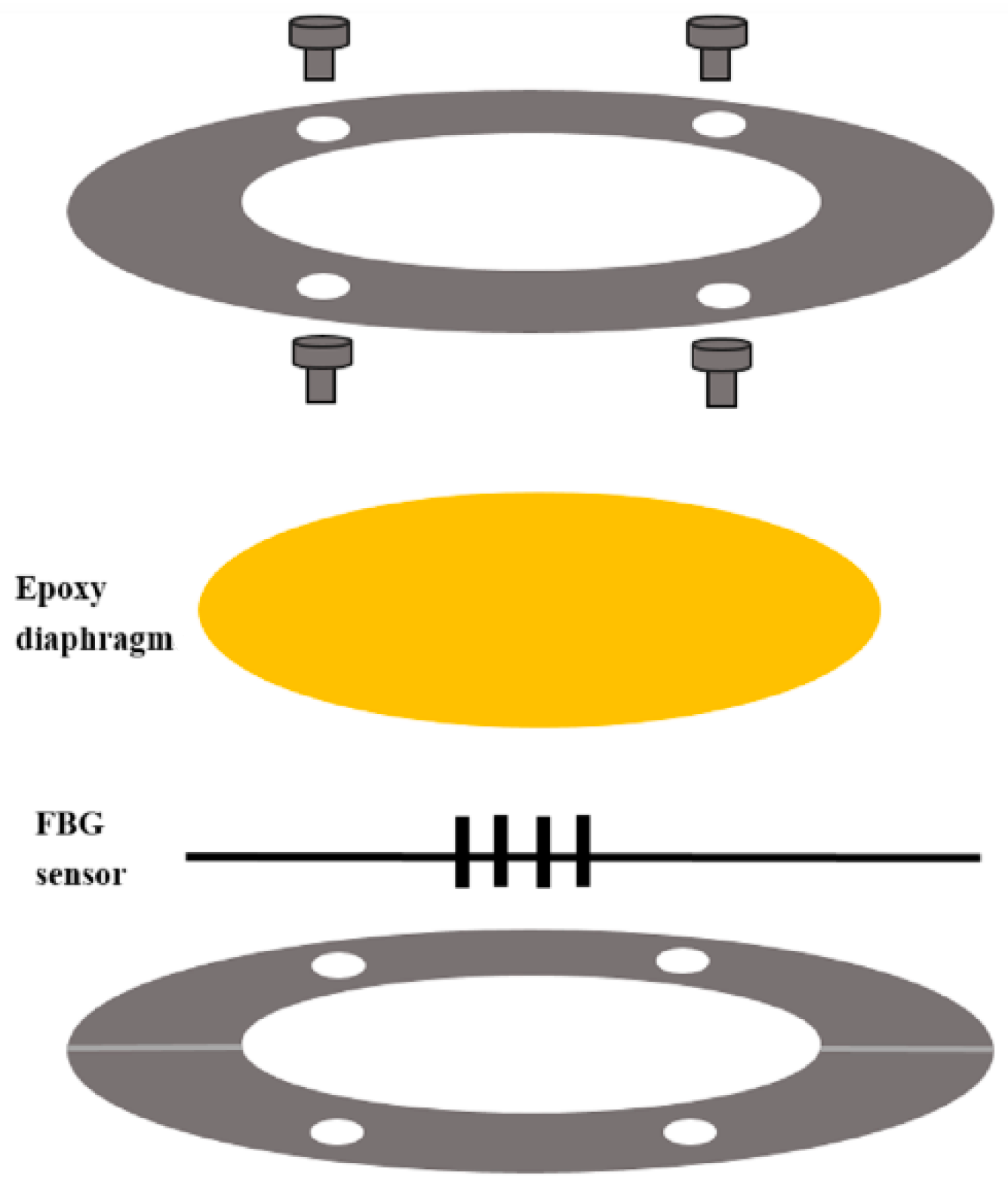

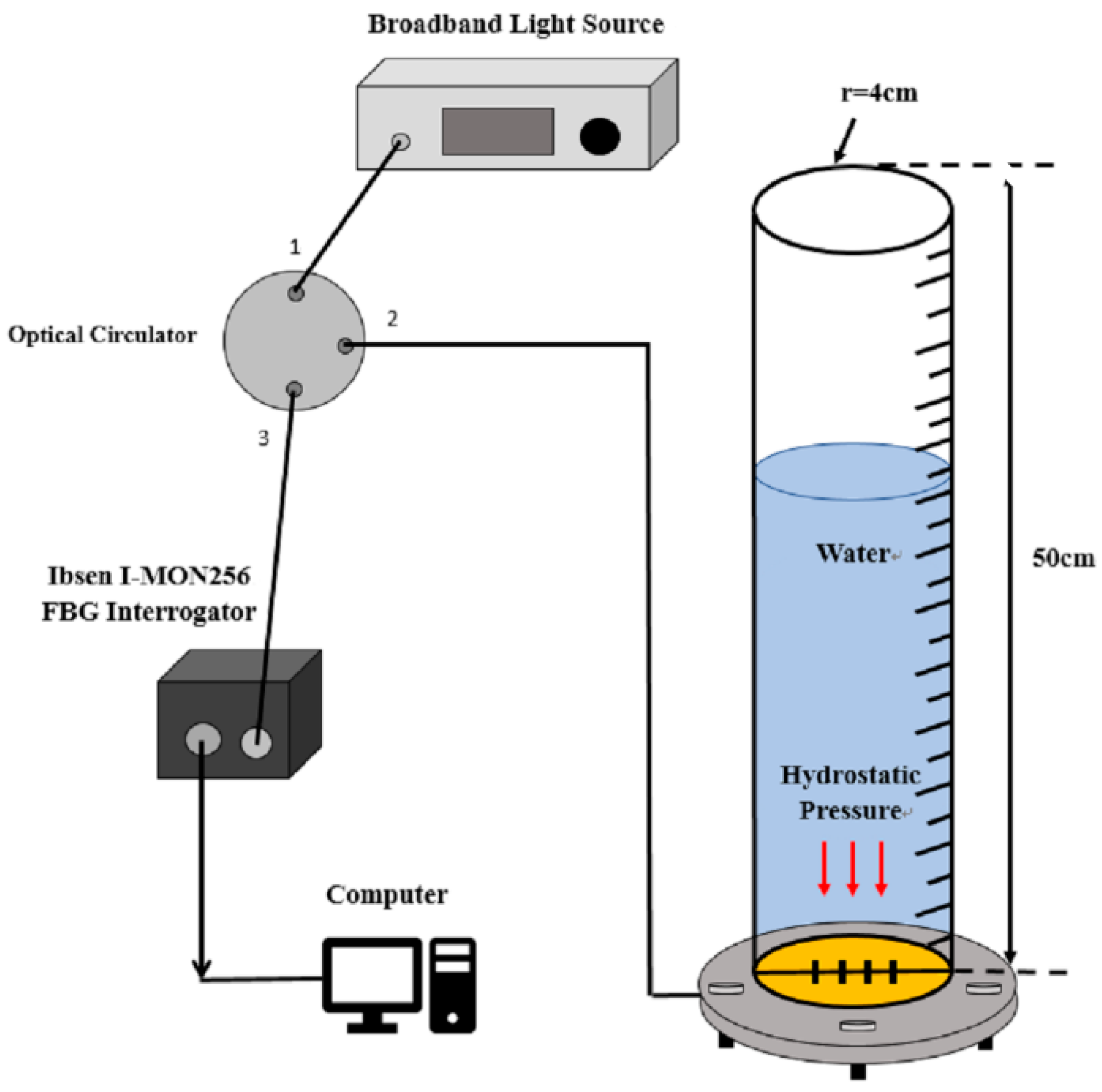





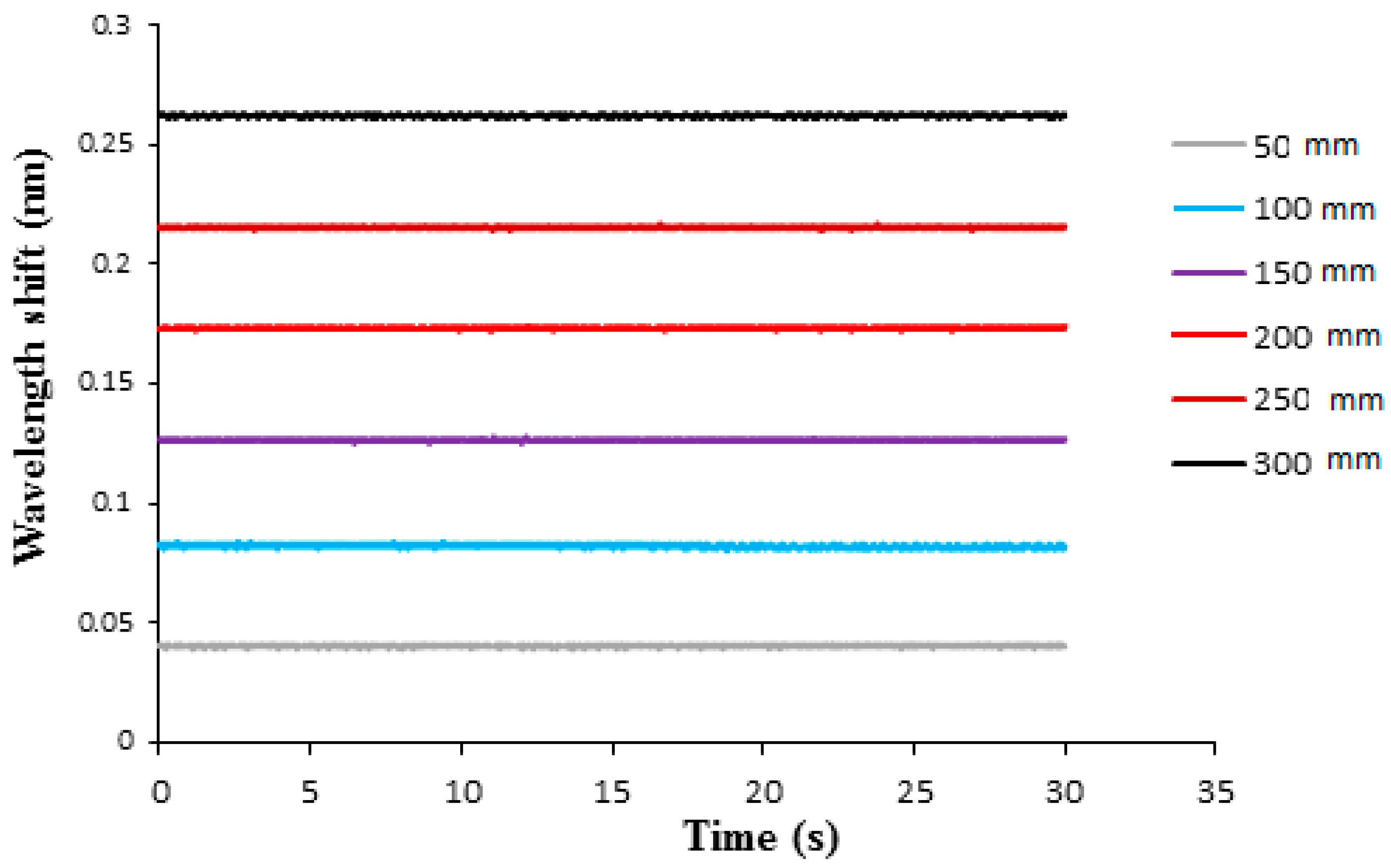
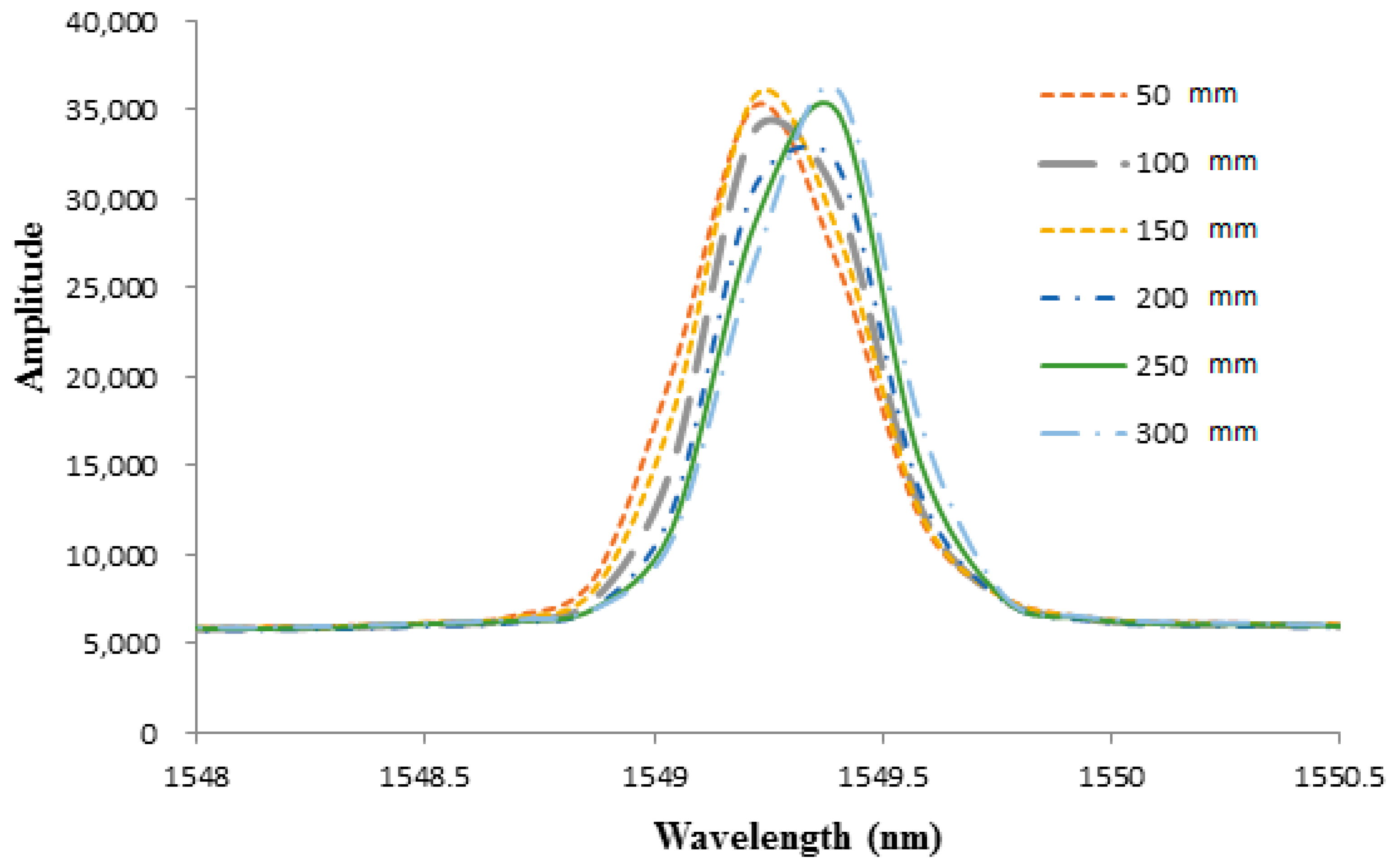
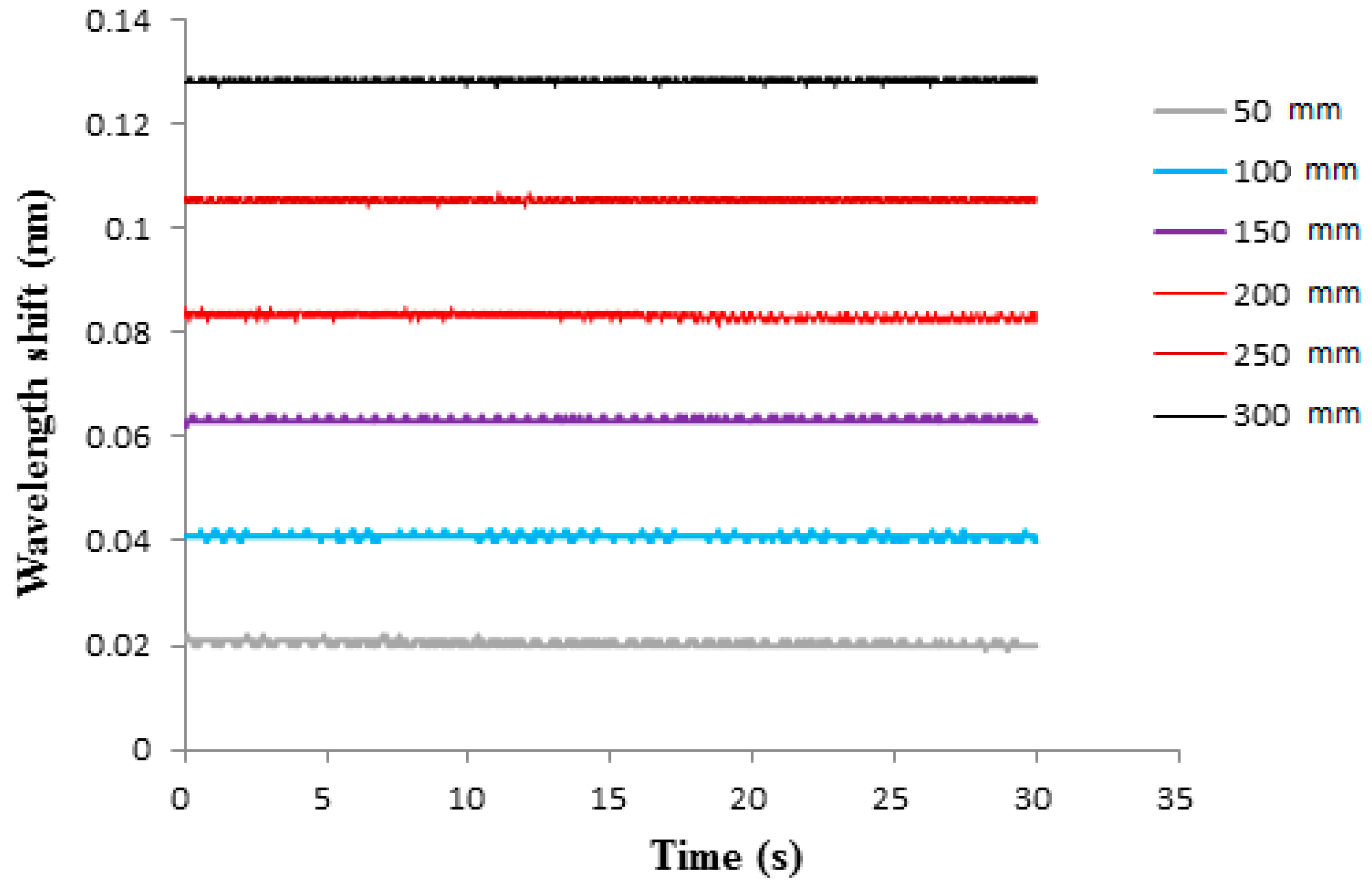
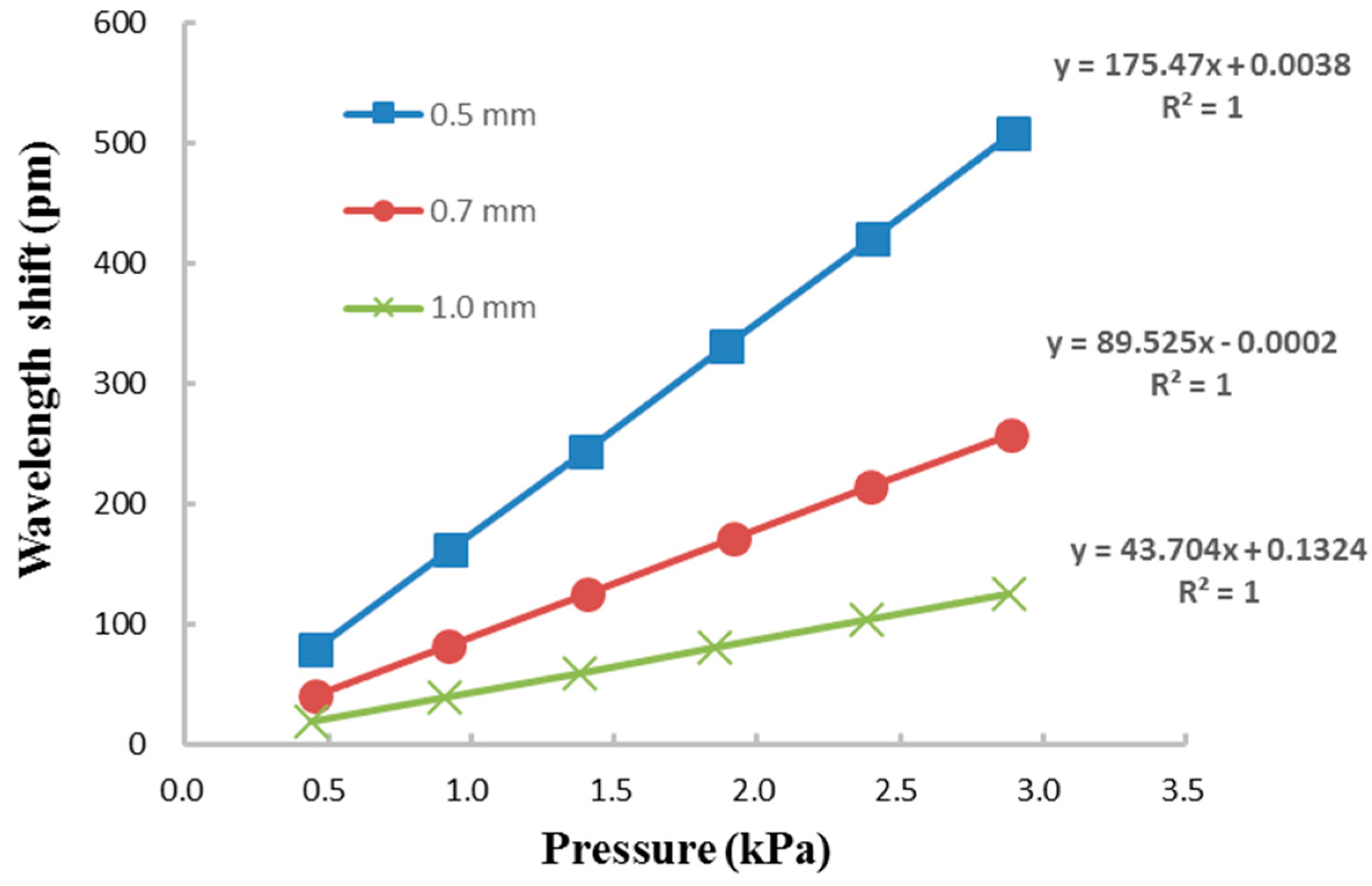
| Water Level (mm) | Theoretical Prediction Equation (9) (Pa) | Experimental Measurement Equation (8) (Pa) | Error | |
|---|---|---|---|---|
| 50 | 491 | 0.081 | 463.53 | 5.59% |
| 100 | 981 | 0.163 | 932.78 | 4.92% |
| 150 | 1472 | 0.25 | 1430.65 | 2.81% |
| 200 | 1962 | 0.337 | 1928.51 | 1.71% |
| 250 | 2453 | 0.422 | 2414.93 | 1.55% |
| 300 | 2943 | 0.51 | 2918.52 | 0.83% |
| Water Level (mm) | Theoretical Prediction Equation (9) (Pa) | Experimental Measurement Equation (8) (Pa) | Error | |
|---|---|---|---|---|
| 50 | 491 | 0.0412 | 460.21 | 6.27% |
| 100 | 981 | 0.0826 | 922.65 | 5.95% |
| 150 | 1472 | 0.129 | 1440.94 | 2.11% |
| 200 | 1962 | 0.173 | 1932.42 | 1.51% |
| 250 | 2453 | 0.216 | 2412.73 | 1.64% |
| 300 | 2943 | 0.261 | 2915.39 | 0.94% |
| Water Level (mm) | Theoretical Prediction Equation (9) (Pa) | Experimental Measurement Equation (8) (Pa) | Error | |
|---|---|---|---|---|
| 50 | 491 | 0.02 | 457.21 | 6.88% |
| 100 | 981 | 0.041 | 937.28 | 4.46% |
| 150 | 1472 | 0.062 | 1417.35 | 3.71% |
| 200 | 1962 | 0.083 | 1897.42 | 3.29% |
| 250 | 2453 | 0.1053 | 2407.21 | 1.87% |
| 300 | 2943 | 0.127 | 2903.28 | 1.35% |
| Pressure Sensitivity | Water Level Sensitivity | ||
|---|---|---|---|
| Present | 175.5 pm/kPa | Present | 16.2 pm/cm |
| Pachava et al. [33] | 32.0 pm/kPa | Diaz et al. [35] | 27.4 pm/cm |
| Ahmad et al. [26] | 8.7 pm/kPa | Marques et al. [34] | 10.2 pm/cm |
| Liang et al. [7] | 0.34 pm/kPa | Song et al. [32] | 1.85 pm/cm |
Publisher’s Note: MDPI stays neutral with regard to jurisdictional claims in published maps and institutional affiliations. |
© 2021 by the authors. Licensee MDPI, Basel, Switzerland. This article is an open access article distributed under the terms and conditions of the Creative Commons Attribution (CC BY) license (https://creativecommons.org/licenses/by/4.0/).
Share and Cite
Her, S.-C.; Weng, S.-Z. Fiber Bragg Grating Pressure Sensor Integrated with Epoxy Diaphragm. Sensors 2021, 21, 3199. https://doi.org/10.3390/s21093199
Her S-C, Weng S-Z. Fiber Bragg Grating Pressure Sensor Integrated with Epoxy Diaphragm. Sensors. 2021; 21(9):3199. https://doi.org/10.3390/s21093199
Chicago/Turabian StyleHer, Shiuh-Chuan, and Shin-Zhong Weng. 2021. "Fiber Bragg Grating Pressure Sensor Integrated with Epoxy Diaphragm" Sensors 21, no. 9: 3199. https://doi.org/10.3390/s21093199
APA StyleHer, S.-C., & Weng, S.-Z. (2021). Fiber Bragg Grating Pressure Sensor Integrated with Epoxy Diaphragm. Sensors, 21(9), 3199. https://doi.org/10.3390/s21093199





